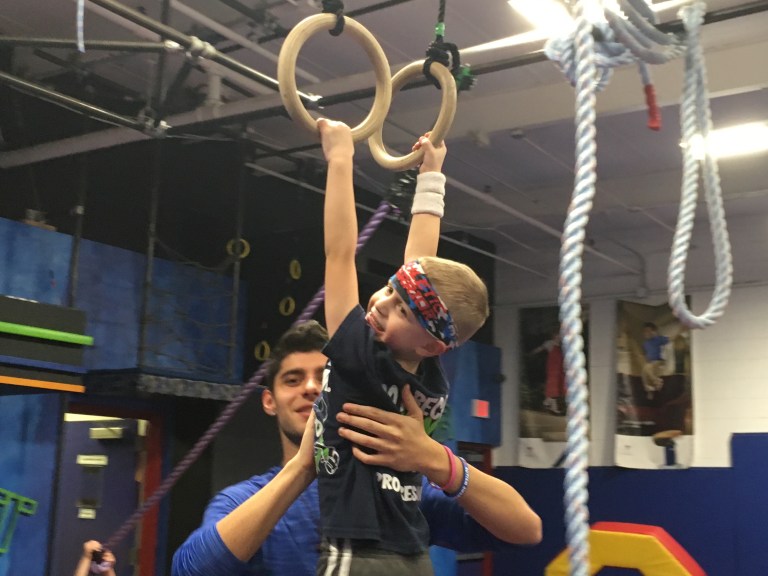
NBC’s “American Ninja Warrior” draws millions of viewers each week who watch as highly trained athletes tackle the show’s notorious obstacle course.
Now some of the show’s youngest fans can become “ninjas” themselves at Progressive Gymnastics East in New Hyde Park, which has developed a physical fitness program based on the show, complete with its own obstacle course, for children ages 4 to 13.
The program has grown from about 50 children when it started in October 2015 to about 250 this fall, said Wendy Cassell, the gym’s founder and director.
They love getting a chance to emulate their favorite ninjas from the show, but the program is also an engaging way to teach children how to set goals and work toward them, said Antonio Rogers, one of its head teachers.
He helped develop the curriculum with Cassell’s daughter Alexis Valvis, a Great Neck South High School graduate.
“We can convey all these excessive ideas of how to become fully fit, sneaking it through this beautiful vehicle of obstacle courses and simple challenges that these kids can attack,” Rogers said.
Progressive Gymnastics East is now working with the U.S. Association of Independent Gymnastics Clubs to spread the program, known as Ninja Athletic Warrior, to other gyms and eventually hold competitions, Rogers said.
The staff has helped establish programs at four other gyms, with a fifth in the works, Cassell said.
Established in New Hyde Park in 2001, Progressive runs 12 55-minute classes a week, each with up to 24 students.
Cassell got the idea for Ninja Athletic Warrior after seeing a similar program at a gym in Pennsylvania and thinking Progressive could do it better, she said. She worked with Jeffrey Tan, a former gymnast who appeared on American Ninja Warrior in 2013, to build the obstacle course.
Teachers start with a five-minute warm-up exercise and then help students train on three to five obstacles, such as balance beams, hanging rings or a high curved wall, said Rogers, who has a bachelor’s degree in physical education from Hofstra University.
The obstacles are each designed to build a particular body part, and instructors sequence them so students get a full-body workout, Rogers said.
As they move through the program, children connect their ability on certain obstacles to strength-training exercises that will help them improve, allowing them to start setting their own fitness goals, Rogers said.
The program also has seven levels, similar to karate’s colored belts, that keep students motivated to get better, said Valvis, who has a master’s degree in exercise physiology from Queens College.
“It’s pretty great that they can come into this place, have a safe place to learn and get all this energy out, feel like they’ve picked up a couple things, but leave with this huge sense of confidence because of what they’ve come into the class to do,” Rogers said.
Ninja Athletic Warrior is a way to get children moving, especially boys, who might not enjoy team sports, Valvis said. Some 215 of the children currently enrolled are boys, she said.
It can be hard to get boys into a gym, a space girls usually dominate, but there are few options for those who don’t want to join a football or baseball team, Cassell said.
“If their sister goes to gymnastics, the boys can do ninja,” Valvis said. “It keeps people in the gym for longer, and people who would never really come to the gym are here now, or maybe they were with us and then left for a while and then came back.”
Gyms across the country have programs based on “American Ninja Warrior,” but spreading the Progressive Gymnastics East curriculum would allow gyms to form associations and host competitions, Cassell said.
Cassell plans to travel to Australia with the Association of Independent Gymnastics Clubs and pitch the program to gymnastics teachers there, she said.
Progressive is also hoping to open a standalone facility to host a program for older teens and adults, Rogers said.
Competing would give children a taste of the competition they see on TV well before they hit the show’s required age of 21, Rogers said.
Ninja competitions could become a sport, given their popularity among children and teenagers and the entrance of obstacle courses into the mainstream of physical fitness, he said.
“By consistently changing up the things that they’re doing, having it be these challenges versus exercises that they have to do, it stimulates them in a different way, and the level of accomplishment after climbing over something and getting to the top is that much better than finishing the 10th rep or the 100th set,” Rogers said.






